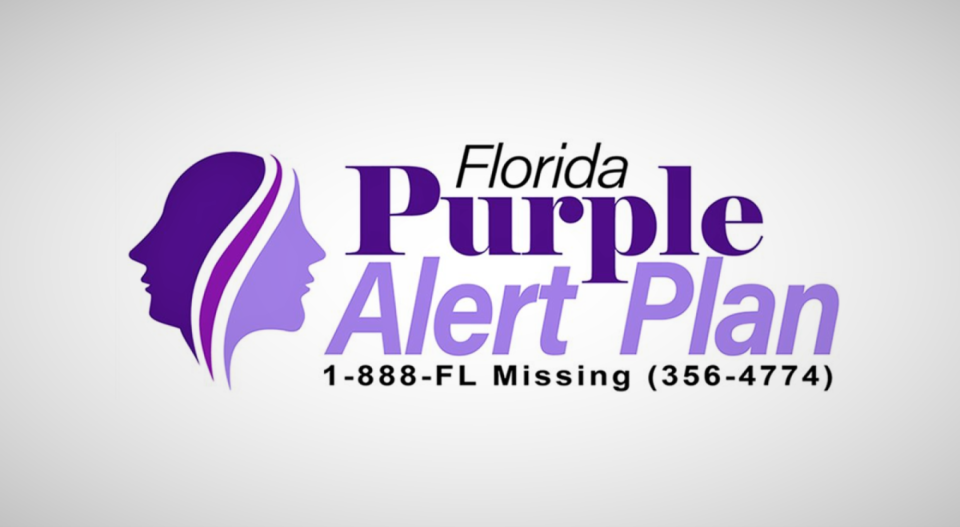What is a Purple Alert? New law adds local emphasis on Florida missing person alerts
- Oops!Something went wrong.Please try again later.
Last week, Gov. Ron DeSantis signed legislation that made Florida's Purple Alert program more local.
Purple Alerts are issued to notify the public when law enforcement is trying to find missing adults with mental or cognitive disabilities that don't stem from Alzheimer's disease or dementia-related disorders, brain injuries, or intellectual or developmental disabilities or related to substance abuse. The missing people need to be found quickly and a fast, widespread request for help speeds up the recovery effort.
When a Purple Alert is broadcast, email and text alerts go out to the public, notices are sent to news media, and messages are added to dynamic message signs on state highways and broadcast on lottery terminals in gas stations, convenience stores and supermarkets across Florida.
But that will no longer be the default response. Here's what changed.
HB 937 puts emphasis on local Purple Alerts
Previously Purple Alerts went out everywhere in the state, with priority given to the area where the person went missing or was expected to be. There will now be two levels of activation, local and state.
Under HB 937, sponsored by Reps. Joe Casello, D-Boynton Beach, and Tom Keen, D-Orlando, in the state House with the companion bill, SB 640, filed by Sen. Lori Berman in the Senate, local law enforcement must develop their own policies for Purple Alerts for missing people who are on foot or in an unidentified vehicle.
Local law enforcement would then distribute information about the missing person to local media outlets, all on-duty law enforcement personnel and any other law enforcement agency in the county.
If there is an identified license plate or other vehicle information available, the local agency may then request a statewide Purple Alert, which would then trigger the highway sign messages, alerts on lottery terminals across the state, and emails and texts sent out to the members of the public who subscribe to them.
The bill also allows local or state law enforcement to open a case with the FDLE's Missing Endangered Persons Information Clearinghouse.
HB 937 goes into effect July 1, 2024.
What is a Purple Alert in Florida?

Added to the FDLE's emergency alert system in 2022, Florida's Purple Alert Plan provides coordination among law enforcement agencies and enlists the help of the public to quickly find missing adults suffering from certain mental or cognitive disabilities.
To qualify for a Purple Alert:
The missing person must be 18 years of age or older and does not qualify for a Silver Alert.
The missing person must have a mental or cognitive disability that is not Alzheimer’s disease or a dementia-related disorder; an intellectual disability or a developmental disability; a brain injury; other physical, mental or emotional disabilities that are not related to substance abuse; or a combination of any of these
The missing person's disappearance indicates a credible threat of immediate danger or serious bodily harm to themselves
The alert is the only viable means by which the missing person is likely to be returned to safety
A detailed description of the missing person suitable for distribution is available
Only law enforcement agencies can request the activation of a Purple Alert. If you would like to report a missing person, contact your local police department or sheriff’s office first, then contact MEPIC at 1-888-FL MISSING (356-4774).
How many active Purple Alerts are there in Florida?
As of April 18, there are nine active Purple Alerts in Florida. The most recent alert was for Hilary Ramos Acosta, 26, who was last seen Monday in the area of the 700th block of East Lisa Lane in Apopka.
How long does someone remain on the Purple Alert list?
The local law enforcement agency determines the status of the alert, but generally, an alert stays active until the missing person is recovered, according to FDLE.
If a Purple Alert is activated and the person is missing in an identified vehicle, Department of Transportation road signs will be activated and remain active for up to six hours.
What are the different color alerts in Florida?
Amber alert: For abducted children, to broadcast critical information as quickly as possible to the media and general public.
Missing Child Alerts: For missing children who are believed to be in life-threatening danger, but not abducted.
Purple Alerts: For missing adults suffering from a mental or cognitive disability.
Silver Alerts: For missing persons 60 years and older, persons 18-59 who lack the capacity to consent, or persons suffering from an irreversible deterioration of intellectual faculties such as Alzheimer's disease or dementia.
Blue Alerts: Issued when a law enforcement officer is killed, suffers serious bodily injury, or is missing while in the line of duty and the suspect, who is considered to pose an imminent threat to the public, is still at large.
How do you receive a Purple Alert?
You can sign up to receive Purple Alerts (or AMBER, Missing Child or Silver Alerts) by subscribing for email or text alerts at the Missing Endangered Persons Information Clearinghouse.
What should you do to help during a Purple Alert?
When you see an alert, FDLE says to make a note of the description of the person and any additional information such as the person’s whereabouts, and if applicable, the vehicle tag, direction of travel and location such as highway, street, city and county, and immediately call 911 or *FHP (347) to respond.
Cheryl McCloud, USA NETWORK - Florida, contributed to this article.
This article originally appeared on The Daytona Beach News-Journal: Florida Purple Alert: New law make missing person alerts more local

